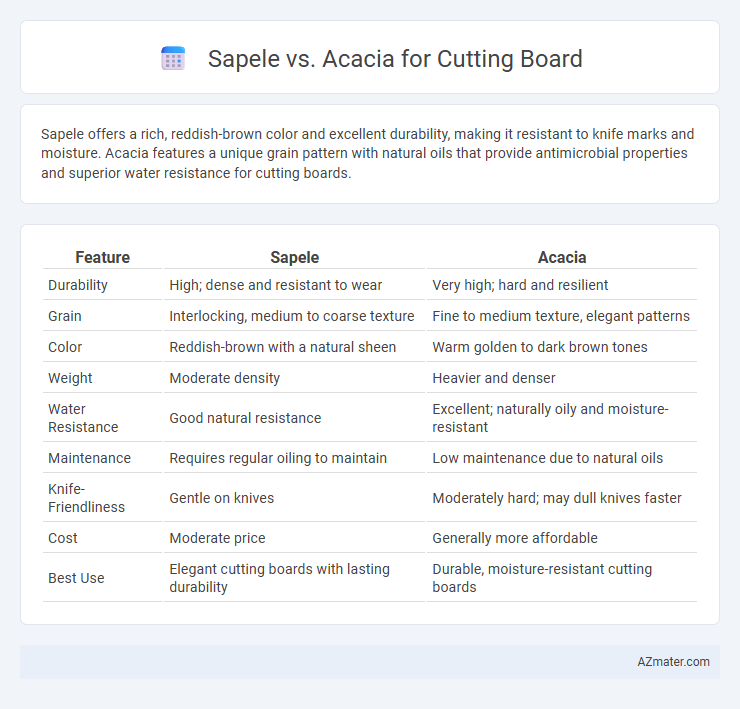Sapele offers a rich, reddish-brown color and excellent durability, making it resistant to knife marks and moisture. Acacia features a unique grain pattern with natural oils that provide antimicrobial properties and superior water resistance for cutting boards.
Table of Comparison
| Feature | Sapele | Acacia |
|---|---|---|
| Durability | High; dense and resistant to wear | Very high; hard and resilient |
| Grain | Interlocking, medium to coarse texture | Fine to medium texture, elegant patterns |
| Color | Reddish-brown with a natural sheen | Warm golden to dark brown tones |
| Weight | Moderate density | Heavier and denser |
| Water Resistance | Good natural resistance | Excellent; naturally oily and moisture-resistant |
| Maintenance | Requires regular oiling to maintain | Low maintenance due to natural oils |
| Knife-Friendliness | Gentle on knives | Moderately hard; may dull knives faster |
| Cost | Moderate price | Generally more affordable |
| Best Use | Elegant cutting boards with lasting durability | Durable, moisture-resistant cutting boards |
Introduction to Sapele and Acacia Wood
Sapele wood, a member of the Mahogany family, is prized for its rich reddish-brown color and fine grain, making it a popular choice for cutting boards due to its durability and resistance to moisture. Acacia wood, known for its striking natural patterns and hard, dense structure, offers excellent antimicrobial properties and longevity in kitchen use. Both woods provide sturdy, aesthetically pleasing options for cutting boards, with Sapele offering a more uniform finish and Acacia showcasing unique grain variations.
Key Differences Between Sapele and Acacia
Sapele cutting boards feature a fine grain and rich reddish-brown color, offering durability and resistance to moisture, ideal for heavy kitchen use. Acacia boards stand out with their striking grain patterns and natural oils, providing excellent water resistance and a harder surface that resists knife marks. Both hardwoods are sustainable options, but Acacia tends to be denser and heavier, while Sapele is slightly softer and easier to maintain over time.
Durability and Hardness Comparison
Sapele wood offers a Janka hardness of 1,410, providing strong resistance to dents and scratches, making it highly durable for cutting boards. In comparison, Acacia boasts a higher Janka hardness rating of around 1,700, indicating superior hardness and better longevity under heavy use. Both woods resist moisture well, but Acacia's denser fiber structure enhances durability, making it a preferred choice for cutting boards subjected to frequent chopping.
Grain Patterns and Aesthetic Appeal
Sapele features a fine, interlocked grain with a rich reddish-brown hue and shimmering iridescence, creating a striking, elegant appearance ideal for cutting boards. Acacia presents a more varied grain pattern with bold, flowing streaks and contrasting tones ranging from light amber to deep brown, offering a rustic and natural aesthetic. Both woods provide durability, but Sapele's uniform grain lends a refined look while Acacia's diverse patterns enhance visual interest and uniqueness.
Food Safety and Hygiene Considerations
Sapele and Acacia woods both offer durable surfaces for cutting boards, but Acacia is often preferred for food safety due to its tighter grain structure, which resists moisture absorption and reduces bacterial growth. Sapele, while aesthetically appealing with its rich reddish-brown color, has an open grain that can trap food particles and harbor bacteria if not properly maintained. Regular oiling and thorough cleaning are essential for both woods to ensure hygiene and extend the lifespan of the cutting board.
Maintenance and Longevity
Sapele offers excellent durability and a natural resistance to moisture, making it easier to maintain with regular oiling and gentle cleaning, which helps prevent warping and cracking over time. Acacia features a dense, tight grain that provides superior strength and stain resistance, requiring minimal maintenance beyond periodic conditioning to preserve its longevity. Both woods withstand daily use well, but Acacia's hardness and natural antibacterial properties give it a slight edge in long-term durability for cutting boards.
Price and Availability
Sapele offers a more affordable option for cutting boards, with prices generally lower than Acacia due to its wider availability in the market. Acacia, known for its durability and rich grain, tends to be pricier and less readily available, as it is sourced from specific regions like Southeast Asia and Australia. Both woods provide quality cutting boards, but Sapele's consistent supply often results in better prices and easier acquisition for consumers.
Eco-Friendliness and Sustainability
Sapele wood, sourced from West African forests, is often harvested from managed plantations, supporting sustainable forestry practices and reducing environmental impact. Acacia, widely grown in scalable plantations and fast-growing, offers excellent renewability and less strain on natural forests, making it an eco-friendly choice for cutting boards. Both woods are durable and biodegradable, but acacia's rapid growth cycle typically results in a lower carbon footprint compared to slower-growing sapele.
Pros and Cons of Sapele Cutting Boards
Sapele cutting boards offer durability and a rich reddish-brown color that resists knife marks and warping, making them a popular choice for kitchen use. However, Sapele can be slightly softer than Acacia, leading to faster surface wear and requiring more frequent maintenance to preserve its finish. While Sapele has natural anti-bacterial properties and a fine grain that provides a smooth cutting surface, it may darken over time and show scratches more prominently compared to the harder Acacia wood.
Pros and Cons of Acacia Cutting Boards
Acacia cutting boards are highly durable and naturally resistant to water, making them ideal for wet kitchen environments. Their dense grain minimizes knife scarring and bacterial buildup, promoting long-lasting hygiene. However, Acacia boards require regular oiling to prevent drying and potential cracking, and they can be heavier and harder to maintain compared to lighter woods like Sapele.

Infographic: Sapele vs Acacia for Cutting Board
 azmater.com
azmater.com